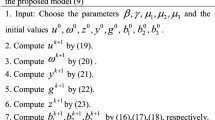Abstract
A novel variational model for image decomposition is proposed. Meanwhile a new cartoon-texture dictionary learning algorithm, which is guided by diffusion flow, is presented. Numerical experiments show that the proposed method has better performance than the existing algorithms in image decomposition and denoising.
Similar content being viewed by others
References
Meyer Y. Oscillating patterns in image processing and nonlinear evolution equations. Boston: University Lecture Series, American Mathematical Society, 2001
Rudin L, Osher S, Fatemi E. Nonlinear total variation based noise removal algorithms. Physica D, 1992, 60: 259–268
Vese L, Osher S. Modeling textures with total variation minimization and oscillating patterns in image processing. J Sci Computing, 2003, 19: 553–572
Osher S, Sole A, Vese L. Image decomposition and restoration using total variation minimization and the H-1Norm. SIAM Multiscale Model Simul, 2003, 1: 349–370
Yin W T, Goldfarb D, Osher S. Image Cartoon-Texture Decomposition and Feature Selection Using the Total Variation Regularized L1 Functional. Technical Report 05-47, UCLA CAM Reports. 2005
Yin WT, Goldfarb D, Osher S. The total variation regularized L1 model for multiscale decomposition. SIAM Multiscale Model Simul, 2007, 6: 190–211
Yin W T, Goldfarb D, Osher S. A comparison of three total variation based texture extraction models. J Vis Commun Image Represent, 2007, 18: 240–252
Duval V, Aujol J F, Gousseau Y. The TVL1 model: A geometric point of view. SIAM Multiscale Model Simul, 2009, 8: 154–189
Buades A, Le T M, Morel J M, et al. Fast cartoon + texture image filters. IEEE Trans Image Process, 2010, 19: 1978–1986
Starck J L, Elad M, Donoho D L. Image decomposition via the combination of sparse representations and a variational approach. IEEE Trans Image Process, 2005, 14: 1570–1582
Jiang L L, Feng X C, Yin H Q. Variational image restoration and decomposition with curvelet shrinkage. J Math Imaging Vision, 2008, 30: 125–132
Li Y F, Feng X C. The split Bregman method for L1 projection problemsv (in Chinese). Acta Electron Sin, 2010, 38: 2471–2475
Li M, Feng X C. A variational model for image decomposition based on wavelet method (in Chinese). Acta Electron Sin, 2008, 36: 184–187
Zhang L, Paul B, Wu X L. Multiscale LMMSE-based image denoising with optimal wavelet selection. IEEE Trans Circuits Syst Video Technol, 2005, 15: 469–481
Engan K, Aase S O, Hakon H J. Method of optimal directions for frame design. In: Proceedings of IEEE International Conference on Acoustics, Speech, and Signal Processing, Phoenix, 1999. 2443–2446
Aharon M, Elad M, Bruckstein A M. The K-SVD: An algorithm for designing of overcomplete dictionaries for sparse representations. IEEE Trans Image Process, 2006, 54: 4311–4322
Mairal J, Sapiro G, Elad M. Learning multiscale sparse representations for image and video restoration. SIAM Multiscale Model Simul, 2008, 7: 214–241
Mairal J, Elad M, Sapiro G. Sparse representation for color image restoration. IEEE Trans Image Process, 2008, 17: 53–69
Elad M, Aharon M. Image denoising via sparse and redundant representations over learned dictionaries. IEEE Trans Image Process, 2006, 15: 3736–3745
Pati Y C, Rezaiifar R, Krishnaprasad P S. Orthogonal matching pursuit: Recursive function approximation with applications to wavelet decomposition. In: Conference Record of The Twenty-Seventh Asilomar Conference on Signals, Systems and Computers, Pacific Grove, 1993. 40–44
Author information
Authors and Affiliations
Corresponding author
Rights and permissions
About this article
Cite this article
Li, Y., Feng, X. Coupled dictionary learning method for image decomposition. Sci. China Inf. Sci. 56, 1–10 (2013). https://doi.org/10.1007/s11432-011-4365-x
Received:
Accepted:
Published:
Issue Date:
DOI: https://doi.org/10.1007/s11432-011-4365-x




